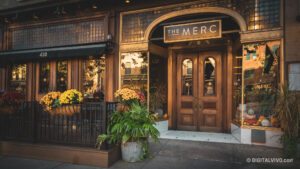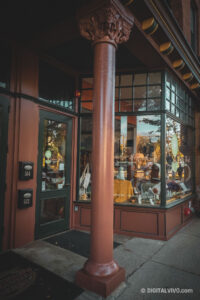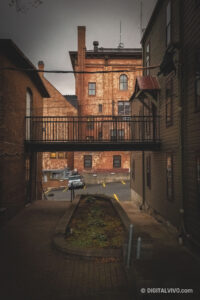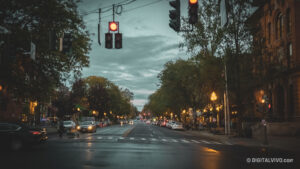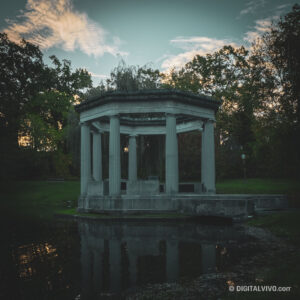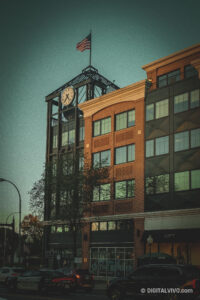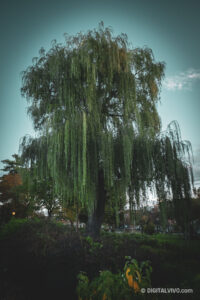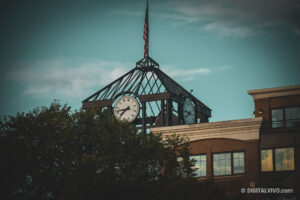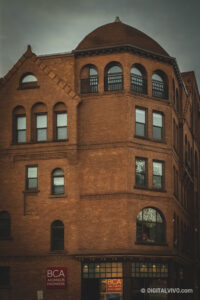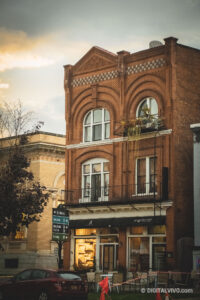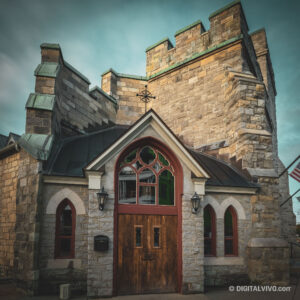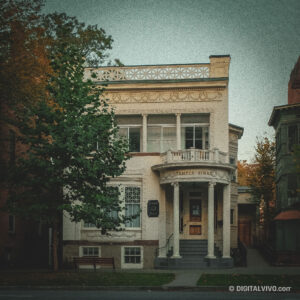
- Posted by digitalvivo
- October 16, 2023
Will the Real Saratoga, Please Stand Up
As a newcomer to photography, I recently embarked on a journey to capture the essence of new places through my lens. When my wife’s work trip took us to Saratoga Springs, New York, I eagerly tagged along, intrigued by the prospect of exploring a city I knew little about. Located just a few hours from my Massachusetts home, the sight of historical brick factories and towering buildings in the downtown area immediately drew me in, reminding me of my hometown’s industrial heritage during the Gilded Age. Excited to uncover the city’s charm and culture, I set out to explore on foot and capture captivating images.

The Allure of Saratoga Springs
Our arrival on a Sunday evening offered only a glimpse of what the town had to offer, but it left a lasting impression. As we strolled to a local restaurant for dinner, the picturesque town came to life under the warm glow of street lamps, illuminating pristine sidewalks and the now-closed shops. The autumn foliage painted the town in hues of yellow, complementing the vibrant red brick buildings basking in the low-hanging sunset. The small downtown area, spanning just five or six blocks, was adorned with grand Gilded Age structures, a testament to the town’s prosperous past. Historically supported by the nearby horse track, which has drawn millions of visitors since its establishment in 1868, Saratoga Springs retained much of its old-world charm. Decorations on buildings, sidewalks, and lampposts paid homage to horse racing, enveloping the town in a nostalgic Gilded Age ambiance. While the racetrack was within reach, I opted to explore on foot, capturing the essence of the downtown with my camera. However, it was the city’s name that sparked a different perspective on what I wanted to capture.
With a name like Saratoga Springs, it’s a reminder of the vital role fresh water played in establishing a thriving community of farms, industries, and residences. Situated on a fault line, Saratoga Springs boasts a natural shale mineral spring known for its believed health benefits. Legends from the Mohawk tribe, dating back centuries before European settlers arrived, still resonate in the town’s parks and buildings, honoring the life-giving properties of the mineral spring. Even today, when you sit down at a restaurant, you’re offered the famous Saratoga Springs mineral water – or so we thought.
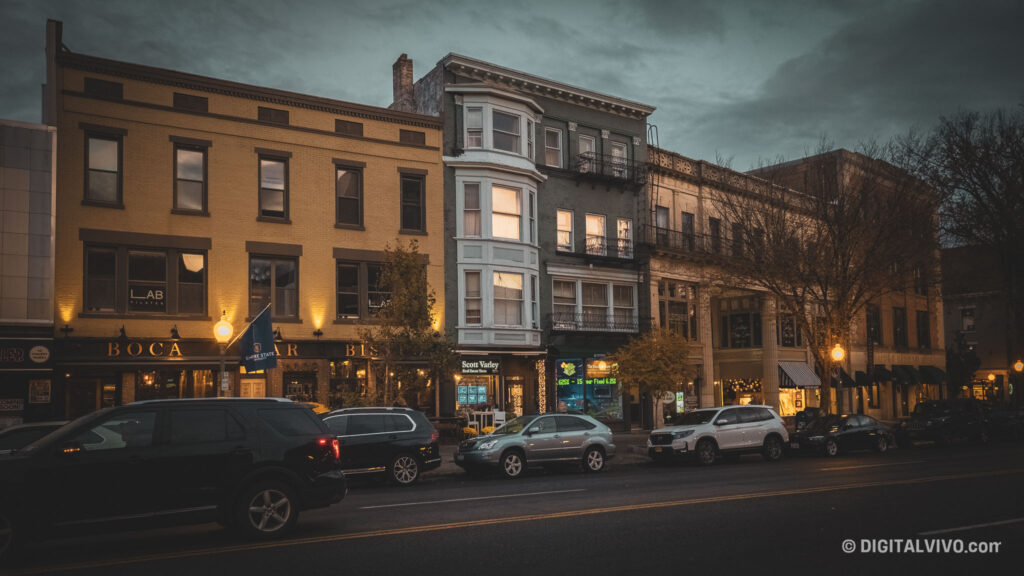
Dining Experiences and Economic Disparities
Saratoga Springs boasts a variety of dining options to suit every palate, from English Pub-style to Mexican, seafood, delis, and more. Notably, the small downtown eschews chain or fast-food restaurants in favor of smaller, themed eateries that evoke a slice of modern-day Americana. It was in these quaint establishments that a common thread began to emerge, though it took some time for me to grasp its significance. Dining in Saratoga Springs proved unpredictable; our first restaurant, specializing in Iberian meats and seafood dishes with a Spanish influence, served our food within five minutes, leaving no time for our wine to arrive – a curious start to our culinary adventure. Our night came and went without much more thought of the town as the wine and mediocre food settled in our stomachs. It wasn’t until the next morning, with daylight exposing the city and its people, that the strange feeling started to creep into my mind.
The strange feeling that had eluded me the previous night began to creep in as daylight bathed the city, revealing its true character. I have a penchant for early morning photography, as the lighting is different and I can explore a city’s layout before the morning rush-hour chaos. This quiet time provides unobstructed views and allows me to capture the city’s essence without the distractions of traffic or crowds. Saratoga Springs, a small town, was particularly eerie in its emptiness. Most people I encountered were maintenance workers diligently cleaning and maintaining the sidewalks, preparing for the influx of conference attendees later that day. As I ventured toward the edge of the main downtown strip, I noticed the illusion of the idyllic All-American town began to crumble, revealing dilapidated buildings and dollar store shopping strips. In one direction, a picture-perfect small town; in the other, the stark reality of everyday life in Saratoga Springs. This contrast prompted a shift in my perception of the town.

The Two Sides of Saratoga Springs
With a population of just under 30,000, the empty streets of the downtown area during the off-season of the racetrack gave the impression of a theme park before opening hours. Around 9:00 am, the town sprang to life as new visitors arrived, hauling presentation materials and luggage to nearby hotels and the convention center. The sidewalks buzzed with activity, amplifying the theme park sensation. As if summoned, locals traversed from one end of the strip to the other, warmly greeting and waving at visitors. Shopkeepers, too, exhibited heightened receptiveness to tourists, delivering what seemed like rehearsed narratives about their stores’ histories and offerings. While undoubtedly sincere and effective in driving sales, the products and actions of these shops reminded me of the gift shops at the conclusion of a museum tour; with the rehearsed lines, the merchandise lacked substance; it was capitalism in its purest form.
I harbor no disdain for capitalism, yet I do take issue with capitalistic behaviors that exploit the very essence of the product they aim to portray. Saratoga Springs, from its meticulously groomed downtown to its impeccably presented storefronts and scripted shopkeeper greetings, employs smoke and mirrors to extract a sense of happiness – it’s akin to an adult theme park. This critique isn’t meant to discredit the town but rather to delve into the nuances of Americana’s “Small Town” ideal that Saratoga Springs proudly aspires to embody. They even have a plaque in front of their town hall proclaiming this aspiration.
The small-town aesthetic aligns with my photographic intent, one I envisioned before arriving in Saratoga Springs. However, interactions within the town prompted my hypothesis of a theme park. Initially, the small-town charm captivates you and adorns you with rose-colored glasses to wear while exploring. A focal point of Saratoga Springs is its spring water. With a history of selling this water in distinctive sapphire-blue glass bottles – symbolic of the city itself – nearly every restaurant presents the choice of water in the form of “Still, Sparkling, or tap,” consistently in that order. It’s a perfectly scripted offer designed to dissuade you from choosing tap water in favor of the bottled mineral spring water that the entire town is famous for. So, what’s the catch? After purchasing this renowned still water, we were surprised to discover that it originated from Maine – a considerable distance from our current location!
Perhaps it was a misrepresentation or a branded water of sorts, but when we inquired with the waiter, his reaction bordered on offense, as though we had insulted his entire business. He shared facts that dissuaded us from further investigation. Curious, we bought a bottle from another restaurant and another from a local general store, all within the same downtown strip – all within the “theme park.” Upon comparison, we found that the water’s sources spanned Maine, Texas, and Pennsylvania. This moment confirmed my suspicion of a theme park where the entire town seemed dedicated to bolstering sales and preserving the essence of the beautifully marketed water in the sapphire-blue glass bottle, simply known as Saratoga. A brief delve into the water bottle company’s history revealed that the once-local company had been sold to a large conglomerate a few years ago, solidifying my belief that the souvenir of my time in Saratoga Springs was no longer an authentic representation of the town, or perhaps it was.

Conclusion
My visit to Saratoga Springs left a lasting impression for several reasons. The pristine downtown appearance juxtaposed with the theme park-like experience I encountered is a paradox that makes this city unique. It reminds me of a wholesome Las Vegas, where everything on the main strip is crafted to resemble something familiar, even if not entirely authentic. While no one truly believes they’re on the French Riviera when visiting Las Vegas’s Bellagio Resort or inside an actual pyramid at the Luxor resort, many may fall for the less obvious tricks of the trade in Saratoga Springs. While not inherently negative, the downtown area’s approach to capitalism mirrors the Vegas style of capitalistic interpretation of a lifestyle, where the main strip serves as the stage, and its residents become actors, all working to perpetuate the town’s ideals and make a profit.
I acknowledge that my observations may come across as harsh, critical, or jaded, but I present them to highlight a facet of true Americana. It’s the epitome of American capitalism: maximizing profits by marketing something from nothing, pricing it to sell for many times its cost, and delivering it with a smile to an unsuspecting customer. If Saratoga Springs aims to become the great American downtown it aspires to be, it has succeeded in becoming something quintessentially American – a theme park city.


















